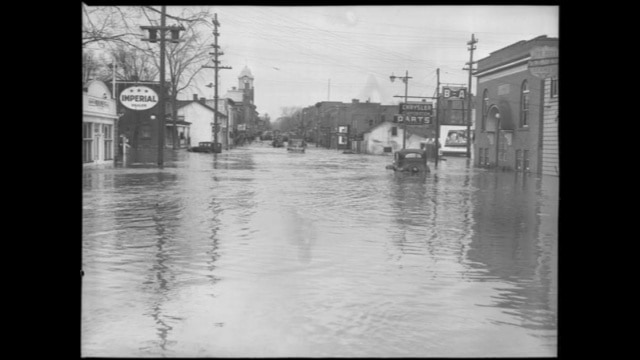VIDEO: Did You Know About Brampton’s Worst Flood in History?
Published January 3, 2019 at 11:10 pm

Chinguacousy Township was first surveyed in 1819, settled by immigrants from Brampton, Cumberland, North England.
Chinguacousy Township was first surveyed in 1819, settled by immigrants from Brampton, Cumberland, North England. John Elliott applied the name Brampton to the land in 1834, and the city has developed a rich history since. But did you know that downtown Brampton sits on a floodplain, and has seen several floods since then?
It’s true. According to Brampton Historical Society Executive (and After Dark ghost tours leader here in B-town) Steve Collie, downtown Brampton used to have a major flood once every ten years or so.
But Brampton’s worst flood happened 70 years ago, on Tuesday March 16, 1948, when the Etobicoke Creek flowed through downtown Brampton.
The Georgetown Herald called it “Brampton’s Worst Flood in History” the day after it happened, and even the Globe and Mail reported on the devastating flood when the Etobicoke Creek overflowed its banks in large part due to developments north of Brampton, where the runoff water would all come down into the channel.
The Globe and Mail said that the flood “wreaked thousands of dollars’ damage” and “swept down through the main business section fast enough to trap workers in the stores.”
With the extreme melt and runoff water, the quick spring thaw, rain, and chunks of ice, downtown Brampton was a mess.
Main Street – you know, where Garden Square, several beloved restaurants and small businesses, and the Rose Theatre now stand – was drowned in over six feet of water, according to Collie.
Downtown Brampton was pretty much destroyed, and it was a hub for merchants big and small, so the entire community was affected.
“The parking metres were only two months old and they got destroyed,” Collie told inbrampton.com. “There were ice chunks breaking store windows.”
The flood happened right around the time that the Heritage Theatre had been bought by Odeon and was set to open.
“A jewellery store was almost completely washed out with windows broken by ice and merchandise scattered in the street. the new theatre, scheduled to open next Monday, was extensively damaged,” said the Georgetown Herald on March 17, 1948.
“They’d put in new seats at the Odeon Theatre, they had the projector sitting there, they hadn’t even done upstairs yet, and they had to send the fire crew to rescue the people because the water was coming up inside of the theatre,” said Collie.
The water was so high that people who didn’t have the chance to run (as they typically would have when downtown Brampton flooded, according to Collie) had to be rescued by emergency crews in boats.
According to Collie, there was a fatality during Brampton’s great flood – a druggist drowned, and their body was found near where Shoppers World now stands.
Cleaning up the 136 acres of downtown Brampton that had flooded took months, though Collie says that people were fishing and rowing boats in the water a matter of days later.
“Following the flood, a decision was made,” said Collie in the fall 2017 edition of the Brampton Historical Society’s newsletter, Buffy’s Corners. “A diversion channel had to be built.”
“The new channel was completed in November 1951 at a cost of $1 million. The dirt that was taken from the channel was used to fill the Main Street South channel and the tunnel behind the stores on Queen Street East.”

From Fire Insurance Plan. Brampton 1894 (revisions 1904 and 1911). Image courtesy of the Region of Peel archives (Buffy’s Corner newsletter edition 19.2, Fall 2017)
When first constructed, Collie says the old tunnel routed behind the stores on the north side of Queen Street East (under Garden Square) and up Vivian Lane where it “matches the main sewer and the Main Street Creek.”
“The Etobicoke Creek may be long gone from downtown Brampton’s landscape but it still influenced and continues to influence the shape and style of the area,” said Collie.
Peel Art Gallery Museum and Archives has this epic video of the incident, produced for the Ontario Department of Planning and Development, Conservation Branch government with footage of the 1948 shot by Cecil A. Chinn:
Cover photo courtesy of Archives Ontario
INsauga's Editorial Standards and Policies


